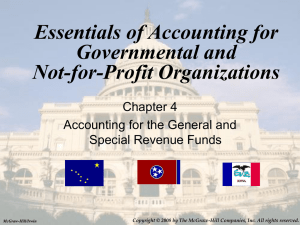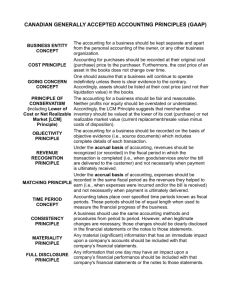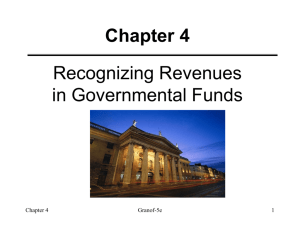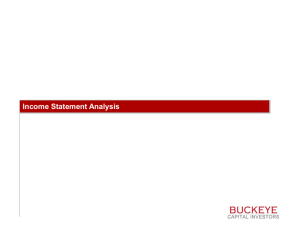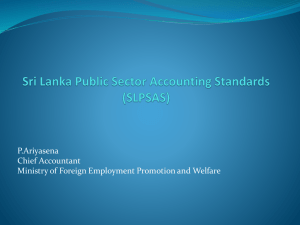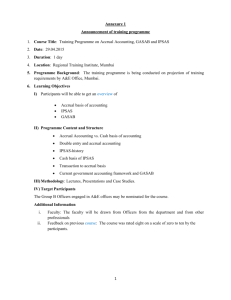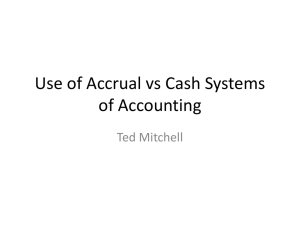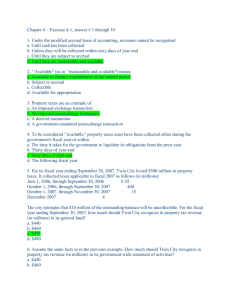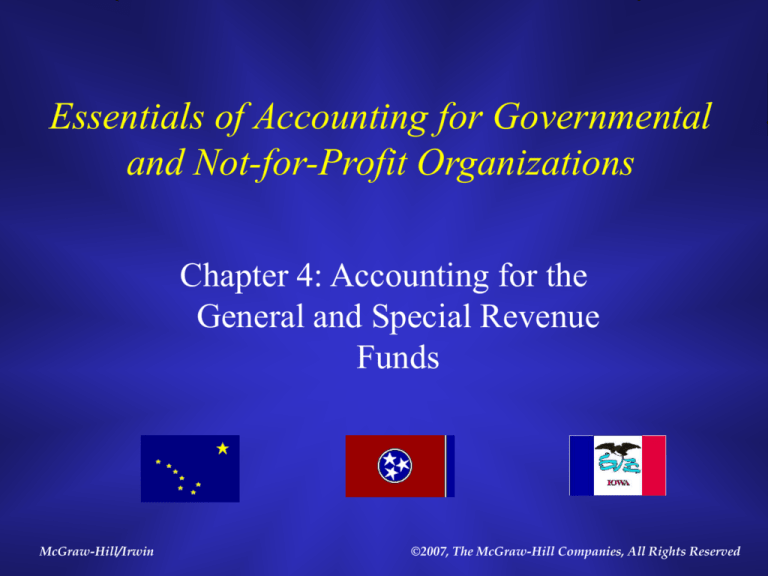
Essentials of Accounting for Governmental
and Not-for-Profit Organizations
Chapter 4: Accounting for the
General and Special Revenue
Funds
McGraw-Hill/Irwin
©2007, The McGraw-Hill Companies, All Rights Reserved
4-2
Overview of Chapter 4
•
•
•
•
Accounting for Nonexchange Transactions
Modified Accrual Basis
Common Entries during the year
The closing process
4-3
Exchange vs Nonexchange
Transactions
GASB Statement No. 33 indicates the timing
will be different for
– Exchange and exchange-like transactions
• These are like true sales — you pay a certain
amount and receive equivalent value in return
– nonexchange transactions
• For taxes and certain other transactions you pay
more or less than the value of services received
4-4
Exchange Transactions
• Revenue resulting
from exchange
transactions is
recognized in the
period(s) that it is
earned
• For example, revenue
from the rental of
government property
would be recognized
over the term of the
lease
4-5
Types of Nonexchange Transactions
1. Imposed nonexchange revenues
property tax, special assessments, fines/forfeits
2. Derived tax revenues
sales, income, motor fuel taxes
3. Government mandated transactions
federal government requires lower level
expenditures
4. Voluntary nonexchange transactions
grants, donations
4-6
Imposed Nonexchange Revenue
• Taxes and other assessments that do not result
from an underlying transaction. Examples include
property taxes and special assessments imposed on
property owners. Also includes fines and forfeits
4-7
Imposed Nonexchange Revenue
Revenue Recognition
– Modified Accrual
(Fund Basis
Statements)
Record the receivable (and an allowance for
uncollectibles) when an enforceable claim exits.
Revenues should be recognized in the period for
which the taxes are levied (i.e. budgeted), but
are also subject to the 60 day rule. Revenues
expected to be collected > 60 days after yearend are deferred.
Revenue Recognition
– Accrual
(Government-wide
Statements)
Record the receivable (and allowance) when an
enforceable claim exits.
Revenues should be recognized in the period for
which the taxes are levied – not subject to the
60 day rule.
4-8
Derived Tax Revenues
• These are taxes assessed on exchange
transactions conducted by businesses or
citizens. Examples include sales, income,
and excise taxes.
4-9
Derived Tax Revenue
Revenue Recognition
– Modified Accrual
(Fund Basis
Statements)
Revenue Recognition
– Accrual
(Government-wide
Statements)
Record the receivable when the taxpayer’s
underlying transaction takes place.
Revenues should be recognized when available
and measurable. Revenues not expected to be
collected in time to settle current liabilities are
deferred (i.e. available and measurable criteria).
Record the receivable when the underlying
transaction takes place.
Revenues should be recognized when the
taxpayer’s underlying transaction takes place,
regardless of when it is to be collected.
4-10
Government Mandated
Nonexchange transactions
• Grants from higher levels of government
(federal or state) given to support a
program. Since the program is required, the
lower-level government has no choice but to
accept. For example, a state may require
schools to mainstream certain students and
provide funds to carry out this mandate.
4-11
Government-Mandated
Nonexchange Revenue
Revenue Recognition
– Modified Accrual
(Fund Basis
Statements)
Revenue Recognition
– Accrual
(Government-wide
Statements)
Record the receivable and the revenue when all
eligibility requirements have been met. Many of
these are reimbursement grants. In this case,
revenue is recognized only when qualified
expenditures have been incurred. Advance
receipts are deferred until expenditures are
incurred. Revenue recognition is subject to the
available and measurable criteria.
The recognition criteria for grants under accrual
accounting are generally the same as modified
accrual. However, recognition in the
government-wide statements does not require
revenues to be collected in time to settle current
liabilities (i.e. available and measurable criteria
do not apply).
4-12
Voluntary Nonexchange
Transactions
• Donations and grants given to support a
program. Since the program is not required,
the receiving government voluntarily agrees
to participate.
4-13
Voluntary Nonexchange Revenue
Revenue Recognition The recognition rules are the same as
– Modified Accrual
mandated grants.
(Fund Basis
Statements)
The recognition rules are the same as
Revenue Recognition mandated grants.
– Accrual
(Government-wide
Statements)
4-14
Review: Modified Accrual vs. Accrual
• Accrual
– Recognize revenues when earned
– Match expenses against the revenues
• Modified Accrual
– Recognize revenues when measurable and available (available
to pay this year’s bills— for example, property taxes received
within 60 days of year end)
– Recognize expenditures when the liability is incurred — no
attempt to match to revenues, match to period of occurrence
only
• Exception — recognize interest and principal payments as
expenditures when DUE
4-15
Modified Accrual Revenue Cycle
• Property tax for 2007 levied = $1,000,000;
$800,000 is collected in calendar year 2007
$120,000 is collected in January and February 2008
$80,000 in collected in March and April 2008
• ENTRIES DURING 2007:
– Record levy:
– 2007 collections
Taxes receivable
Revenue (tentative)
Cash
1,000,000
800,000
Taxes Receivable
– Year end adjustment: Revenue
80,000
Deferred Revenue
•
1,000,000
800,000
80,000
(Receipts of property taxes over 60 days after year end will be a 2008 revenue)
4-16
Modified Accrual Expenditure Cycle
Supplies are ordered at an estimated cost of $ 3,000
Supplies are received with an actual cost of $ 3,000 plus shipping of $ 250
Invoice from the supplies is paid
• Journal Entries
–
Place Order
Receive Goods
Encumbrances
3,000
Budgetary Fund Balance
Reserve for Encumbrances
3,000
Expenditures
Accounts Payable
3,250
Budgetary Fund Balance
Reserve for Encumbrances
Encumbrances
Payment
Accounts Payable
Cash
3,250
3,000
3,000
3,250
3,250
4-17
Quasi-External Transactions
• These are between funds but they are exchangelike transactions with an objective basis for
determining the amount
• Treated as revenue and expense or expenditure
• Example, sale of electricity by the Electricity Enterprise
fund to the General Fund
• Would be treated as revenue for Enterprise Fund and
expenditure for General Fund
• GASB 34 calls these “Interfund Services
Provided & Used” instead of quasi-external
4-18
Reimbursements
• Assume the UPS delivers a $10,000 shipment of supplies
which are initially recorded in the General Fund as follows:
GF: Expenditures
Accounts Payable
$10,000
$10,000
• Later, it is discovered that $2,000 of these supplies were for
the Electricity Enterprise fund, and the supplies are given
to the Electricity fund. The following would be recorded:
GF: Due from Electricity
Expenditures
EF: Expenditures
Due to General Fund
$2,000
$2,000
$2,000
$2000
4-19
Reimbursements Cont’d
• Reimbursements
do not show up
separately on the
Activity or Budget
statement, but are
internal balance
corrections
• When the reimbursement
is made, the expense or
expenditure is recorded
in the correct fund and
the incorrect expense or
expenditure is decreased
4-20
Transfers
• Any shifting of resources from one fund
to another where there is no expectation
that the amounts will be repaid.
• Transfers In are considered Other
Financing Sources
• Transfers Out are considered Other
Financing Uses
• Recurring Transfers such as for debt
service may be built into the budget
4-21
The Closing Process - Slide 1
• Background — the business closing
process
– Close revenues and expenses to income
summary, close income summary and
withdrawals to Retained Earnings or Capital
4-22
The Closing Process - Slide 2
• Closing process for government type funds
needs to accomplish the following:
– Close budgetary accounts
– Close Revenues, expenditures, encumbrances,
and related other financing sources or uses to
Fund Balance
– Reclassify the Budgetary Fund Balance –
Reserved for Encumbrances to Fund Balance –
Reserved for Encumbrances

